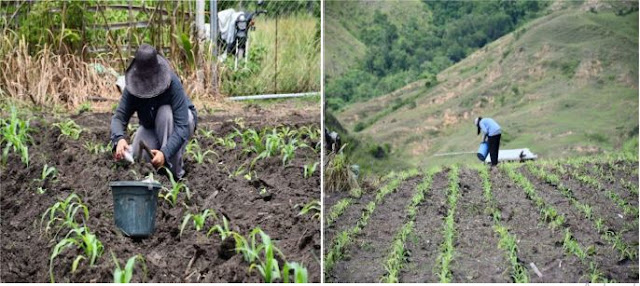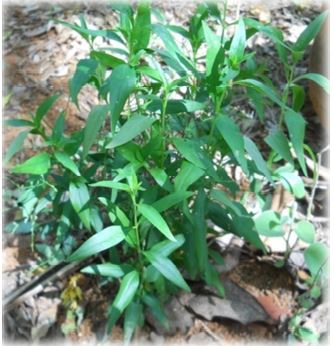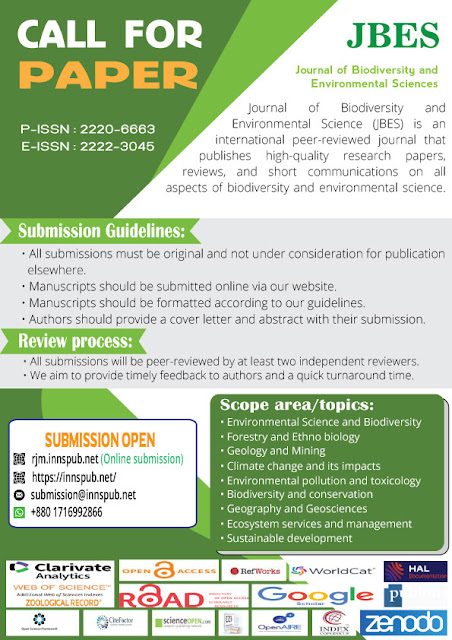Geovanna Alicia Dantas
Gomes, Paulo César Ferreira Linhares, Karen Geovana da Silva Carlos, Roberto
Pequeno de Sousa, Janilson Pinheiro de Assis, Luiz João Rebouças de Souza, Ana
Patricia Silva Maia, Luciane Karine Guedes de Oliveira, Maria Elisa da Costa
Souza, Walter Rodrigues Martins, Eudes de Almeida Cardoso, and Hiago Alves
Moreira, from the different institute of the Brazil. wrote a research article
about, Semi-Arid Lettuce Growth: Hairy Woodrose & Carnauba Straw Mix,
entitled, “Mixture of hairy woodrose (Merremia aegyptia L.) with carnauba straw
(Copernicia prunifera) in the productivity of lettuce in the semi-arid region
of Brazil”. This research paper published by the International Journal of Agronomy and Agricultural Research | IJAAR. an open access scholarly
research journal on Agronomy under the affiliation of the International
Network For Natural Sciences | INNSpub. an open access
multidisciplinary research journal publisher.
Abstract
The use of mixtures of
organic fertilizers present in the cultivation areas is of paramount importance
for farmers who produce in the family farming system, in this sense, the
objective was to study the mixture of hairy woodrose (Merremia aegyptia L.)
with carnauba straw (Copernicia prunifera) in the productivity of lettuce in
the semi-arid region from Brazil. The experiment was carried out in a
greenhouse in the experimental area of the Department of Agronomic and Forestry
Sciences. The experiment was carried out in a completely randomized design in a
5 x 2 factorial scheme, with three replications. The first factor consisted of
five amounts of the mixture of jitirana with carnauba straw (0.0; 1.5; 3.0; 4.5
and 6.0kg m-2 of area), and the second factor for the forms of application
to the soil (embedded and cover). The lettuce cultivar planted was crespa,
which is widely sold in the semi-arid region of Brazil. The evaluated
characteristics were: Plant height, diameter, number of leaves, lettuce
production and dry mass. The research results showed that the amount of 4.5kg m
contributed to the increase of the evaluated characteristics, with values of
115 and 11.97g plant-1. The use of a mixture of organic fertilizers (hairy
woodrose and carnauba straw) was extremely effective in the production of
vegetable crops, bringing agronomic advantages to the producer.
Read more : Preserving Kalinga's Heirloom Corn Varieties | InformativeBD
Introduction
Aiming at an agroecological production, many researchers and farmers seek a sustainable and diversified agriculture with systems of use with low chemical inputs (Altiere, 2002). According to Linhares et al. (2018) the use of organic sources in the region of Mossoró, RN, Brazil is of great importance for vegetable growers, with manure (beef, goat and poultry) as inputs, however, the dependence on these sources contributes to the increase of production costs, as farmers do not always have these resources available on their properties.
Aiming at agroecological alternatives, many researchers have carried out research with farmers who seek sustainable agriculture with diversified systems with low use of chemical inputs (Altieri, 2002), which is of great value to farmers who work in the organic agriculture system. In these areas, where various vegetables are grown, lettuce (Lactuca sativum L.) is an annual herbaceous plant, originating in the Mediterranean, with a small, unbranched stem, to which the leaves attach (Santos et al., 2011) , being the most important leafy vegetable in the diet of the Brazilian people, consumed as a salad (Yuri et al., 2006).
In the semi-arid region, organic fertilization is widely used in the production of lettuce (Linhares et al., 2022). The amount to be used depends on the quality of the available fertilizer and local conditions, soil, climate and management (Freire et al., 2013). However, when green manure is applied to the soil, it provides ideal edaphic conditions for greater vegetable production, given the productive potential of phytomass and nitrogen concentration of spontaneous species from the semi-arid region, compatible with legumes, such as hairy woodrose (Merremia aegyptia L.) (Linhares et al., 2021).
This species presents green and dry phytomass production in the order of 40000 and 6000kg ha-1, respectively, with an average nitrogen content of 23.0g kg-1 and a carbon-nitrogen ratio of 23/1, being quite prominent during the rainy season in the semiarid region and found in the cultivation areas of farmers who work in the production of vegetables in an organic system in the region of Mossoró, RN, Brazil (Linhares et al., 2021).
Another species that is important in terms of use as an organic fertilizer is the carnauba tree (Copernicia prunifera L.), which occurs in the semi-arid region and is used by farmers in the production of vegetable crops (Linhares et al., 2014).
Several scientific studies have shown the use of alternative organic sources in the semi-arid region to meet the nutritional needs of vegetable crops, such as coriander (Linhares et al., 2018a; Linhares et al., 2018b; Linhares et al., 2014a and Linhares et al., 2012), lettuce (Linhares 2009) carrot (Linhares et al., 2014b) and radish (Linhares et al., 2013).
In this sense, it is extremely important to use alternative organic sources that provide satisfactory edaphic conditions for the development of vegetable crops. Thus, the objective was to evaluate the mixture of hairy woodrose (Merremia aegyptia L.) with carnauba straw in the productivity of lettuce in the semi-arid region of Brazil.
Reference
Altieri M. 2002.
Agroecology: scientific basis for sustainable agriculture (Agroecologia: bases
científicas para uma agricultura sustentável). Guaíba: Agropecuária 592p.
Barbosa JC, Malheiros
EB, Banzatto DA. 1992. ESTAT: Um sistema de análises estatísticas de
ensaios agronômicos. Jaboticabal: Unesp, Versão 2.0.
Carmo Filho F, Oliveira
OF. 1995. Mossoró: um município do semiárido nordestino, caracterização
climática e aspecto florístico. Mossoró: ESAM, (Coleção Mossoroense, Série B)
62p.
Empresa Brasileira de
Pesquisa Agropecuária- EMBRAPA. 2018. Sistema brasileiro de classificação
de solos. 2nd ed. Rio de Janeiro: Embrapa p.306.
Freire LR, Balieiro FC,
Zonta E. 2013. Manual de calagem e adubação do Rio de Janeiro. Seropédica:
Editora Universidade Rural 430p.
Kronka SN, Banzato DA. 1995.
(Estat) system for statistical analysis 2. 3. ed. Jaboticabal: Funep 243 p.
Linhares PCF, Maracajá
PB, Sousa RP, Assis JP. 2022. Adubação verde com flor-de-seda {Calotropis
procera (Aiton) W. T. Aiton} em culturas olerícolas na região semiárida
[livro eletrônico]: In: Linhares PCF, Maracajá PB, Sousa RP, Assis JP, Alves
LS, Silva NV, Medeiros AC, Gomes GAD. Aplicação da flor-de-seda {Calotropis
procera (Aiton) W. T. Aiton} como adubo verde em hortaliças folhosas
(coentro, rúcula e alface). Nova Xavantina, MT: Ed. Pantanal. 96p. Cap. 2,
p.29-40. https://doi.org
/10.46420
Linhares PCF, Maracajá
PB, Liberalino Filho J, Assis JP, Sousa RP, Medeiros AC. 2021. Jitirana (Merremia
aegyptia L. Urban) [livro eletrônico]: Potencialidade de uso como espécie
espontânea do semiárido na adubação verde de hortaliças. In: Linhares PCF,
Cunha LMM, Silva NV, Neves AM, Medeiros BBM and Paiva AC. Fitomassa verde e
seca, teores e acúmulo de macronutrientes da jitirana (Merremia aegyptia L.
Urban) em diferentes estádios fenológicos- Nova Xavantina, MT: Ed. Pantanal.
96p. Cap. 2, p.24-45. https://doi.org/ 10.46420
/9786588319901
Linhares PCF, Assis JP,
Sousa RP, Sá JR, Pereira MFS, Ramalho WB, Silva RIG, Silva RA, Pereira KLV. 2018a.
Optimized amount of hairy woodrose (Merremia aegyptia L.) in the
productivity of coriander cultivars. Bulgarian journal of Agricultural
Science 24(2), 654-659.
Linhares PCF, Cunha
LMM, Sousa RPde, Neves APM, Assis JPde, Almeida AMBde, Pereira MFS, Cardoso EA,
Paula JAA, Alves LS. 2018b. Agronomic Efficiency of Organic Fertilised in
the Production of the Intercropping of Coriander and Mint in the Northeastern
Brazil. Journal of Experimental Agriculture International 29(1), 1-11. https://doi.org/ 10.9734/
JEAI/2019/45689.
Linhares PCF, Maracajá
PB, Pereira MFS, Assis JP, Sousa RP. 2014a. Roostertree (Calotropis
procera) under different amounts and periods of incorporation on yield of
coriander. Revista Verde de Agroecologia e Desenvolvimento Sustentável 9(2), 07-12.
Linhares PCF, Assis JP,
Sousa RP, SÁ JR, Pereira MFS, Ramalho WB, Silva RIG, Silva RA, Pereira KLV. 2018b.
Optimized amount of hairy woodrose (Merremia aegyptia L.) in the
productivity of coriander cultivars. Bulgarian Journal of Agricultural
Science 24(4), 654-659.
Linhares PCF, Cunha
LMM, Sousa RPde, Neves APM, Assis JPde, Almeida AMBde, Pereira MFS, Cardoso EA,
Paula JAA, Alves LS. 2018c. Agronomic Efficiency of Organic Fertilised in
the Production of the Intercropping of Coriander and Mint in the Northeastern
Brazil. Journal of Experimental Agriculture International 29(1), 1-11. https://doi.org/10.9734/JEAI/2019/45689.
Linhares PCF, Oliveira
JD, Pereira MFS, Fernandes JPP, Dantas RP. 2014a. Espaçamento para a
cultura do coentro adubado com palha de carnaúba nas condições de Mossoró-RN.
Revista Verdede Agroecologia e Desenvolvimento Sustentável 9(3), 01-06.
Linhares PCF, Maracajá
PB, Oliveira JD, Silva RIG. 2014b. Períodos de incorporação da jitirana
mais palha de carnaúba na produtividade da cenoura. Agropecuária Cientifica no
Semi-árido 10(3), 100-104.
Linhares PCF. 2013.
Green manure as soil conditioner. Revista Campo e negócios 127(1), 22-23.
Linhares PCF, Pereira
MFS, Assis JP, Bezerra AKH. 2012. Quantidades e tempos de decomposição da
jitirana no desempenho agronômico do coentro. Ciência Rural 42(2), 243-248.
Linhares PCF, Pereira
MFS, Silva ML, Maracajá PB, Moreira JC, Souza AAJ. 2013. Otimização da
quantidade de jitirana incorporada ao solo no rendimento agronômico do
rabanete. Agropecuária cientifica no Semi-árido 9(2), 42-48.
Linhares PCF. 2009.
Vegetação espontânea como adubo verde no desempenho agroeconômico de hortaliças
folhosas. 109 f. Tese (Doutorado em Fitotecnia: Área de Concentração em
Agricultura Tropical) – Universidade Federal Rural do Semi-Árido, Mossoró,
Brazil.
Meurer EJ. 2007.
Factors influencing plant growth and development. In: Novaes, RF, Alvarez VVH,
Barros NF, Fontes RLF, Cantarutti RB, Neves JCL. (eds.) Fertilidade do solo.
Viçosa: SBCS 65-90.
Neves APM, Linhares
PCF, Souza RP, Assis JS, Neves AM, Cunha LMM, Almeida AMB, Pereira MFS, Alves
LS. 2018. Successive crops of lettuce fertilized with bovine manure in the
presence and absence of mung bean. International Journal of Development
Research 08(1), 19754-19760.
Oliveira EQ, Souza RJ,
Cruz MCM, Marques VB, França AC. 2010. Produtividade de alface e rúcula,
em sistema consorciado, sob adubação orgânica e mineral. Horticultura
Brasileira 28(1), 36-40.
Paiva, Laíza Gomes de. 2016.
Estudo da alface e coentro em consórcio e monocultivo sob diferentes adubações
em dois períodos/Laíza Gomes de Paiva. Pombal 55 p. Monografia
(Bacharelado em Agronomia)- Universidade Federal de Campina Grande, Centro de
Ciências e Tecnologia Agroalimentar, 2016.
Santos D, Mendonça RMN,
Silva SM, Espíndola JEF, Souza AP. 2011. Produção comercial de cultivares
de alface em Bananeiras. Horticultura Brasileira 29(1), 609-612.
Taiz L, Zeiger E. 2017.
Plant Physiology, 3rd ed. Porto Alegre: Artmed 954 p.
Yuri JE, Resende GM,
Mota JH, Souza RJ, Carvalho JG. 2006. Produção de alface-americana em
função de doses e épocas de aplicação de zinco. Ciência e Agrotecnologia 30(2), 665-669.









%20in%20full.JPG)
















%20in%20full.JPG)

